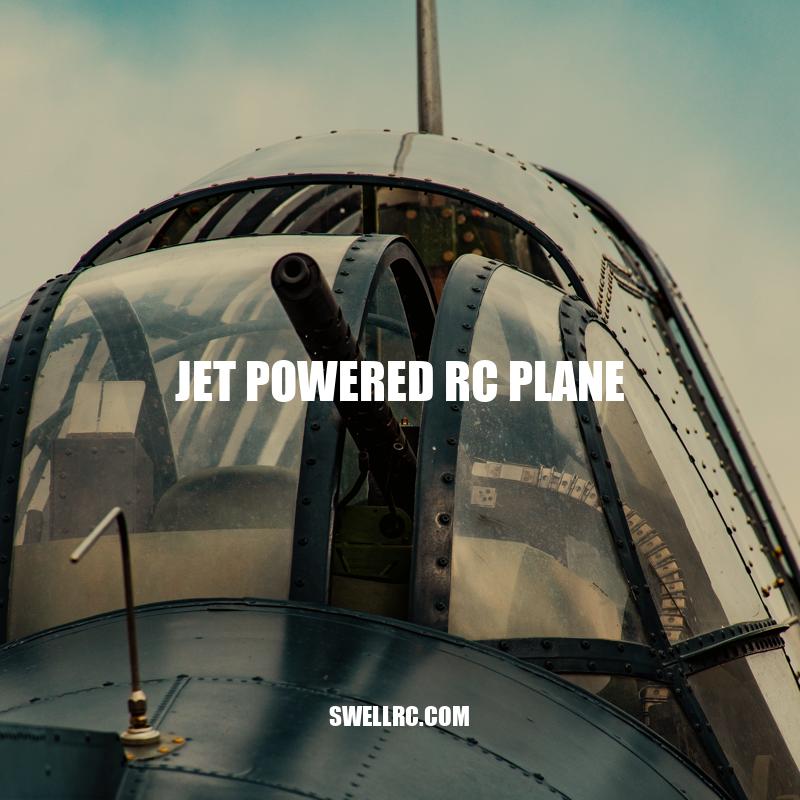Jet Powered RC Planes: The Ultimate Guide.
Jet Powered RC Plane: The Ultimate Flying Machine
For aviation enthusiasts and hobbyists alike, the jet powered RC plane provides an unparalleled experience of powerful flight and exhilaration. With advanced technology and intricate designs, these miniature aircrafts offer a thrilling opportunity to fly with complete control, performing amazing aerobatics and stunts in open fields or air shows. Jet powered RC planes are capable of reaching high speeds and altitudes, making them a popular choice among those who seek excitement and adventure. Whether you’re an experienced pilot or just starting out, the jet powered RC plane is sure to provide the ultimate flying machine. In this article, we will delve into the different components, building process, maneuvering techniques, and current and future developments of jet powered RC planes, as well as provide tips for selecting the right aircraft for your needs. So get ready to take off and soar to new heights with the jet powered RC plane.
Jet powered RC planes are complex and dynamic machines, consisting of several intricate components that are essential for its operation. Whether you are purchasing a pre-built aircraft or building your own, it’s essential to understand the different parts that make up the jet powered RC plane.
- Engine: The engine is the beating heart of the plane, providing the necessary power and propulsion for flight. Jet powered RC planes typically use a turbine engine, which runs on a fuel mixture of kerosene and oil and is ignited by an electric spark.
- Fuel Tank: The fuel tank holds the fuel mixture and is typically located under the cockpit or near the engine. It is important to ensure that the fuel level remains sufficient during flight to avoid mid-air engine failure.
- Receiver: The receiver is a small device that captures the radio frequency signals transmitted by the transmitter and sends them to the plane’s control surfaces.
- Control Surfaces: There are four control surfaces on the plane, which are the ailerons, elevator, rudder, and throttle. The ailerons control roll, the elevator controls pitch, the rudder controls yaw, and the throttle controls the speed of the engine.
- Battery: The battery provides power to the receiver and other electronic components on the plane.
- Wings: The wings provide lift and stability during flight and are typically made of lightweight materials like balsa wood or foam core boards.
- Fuselage: The fuselage is the main body of the plane, which houses the engine, fuel tank, and other components. It also provides stability and helps to control the plane’s direction during flight.
Understanding the different components of a jet powered RC plane is crucial for proper operation and maintenance. It’s essential to ensure that each component is functioning correctly and in good condition before each flight. Websites like RC Universe and HobbyKing offer a wide range of jet powered RC planes and parts for those interested in building or purchasing their own aircraft.
How do RC jet planes work?
RC jet planes work by incorporating a propulsion system that uses the force of expelled gases to create thrust, resulting in forward motion. These planes typically use a small-scale version of a gas turbine engine, which is powered by a fuel mixture of kerosene and oil.
Here are some key components of RC jet planes:
| Component | Description |
|---|---|
| Turbine engine | Produces the thrust necessary for flight |
| Fuel tank | Stores the fuel mixture |
| Radio receiver/transmitter | Controls the plane’s movements in flight |
RC jet planes can reach impressive speeds and altitudes, and require a skilled pilot to operate. For those interested in purchasing RC jet planes or learning more about them, there are several websites such as Horizon Hobby and Motion RC that offer various models and resources.
Building Your Own Jet Powered RC Plane
For those looking to dive deeper into the world of jet powered RC planes, building your own aircraft can be a fun and rewarding experience. Here are some steps to get started:
- Research and planning: Determine what kind of plane you want to build, find a plan or blueprint, and purchase the necessary materials and components.
- Construction: Assemble the various parts of the plane according to the blueprint and follow the recommended steps and safety guidelines.
- Testing: Once the plane is complete, conduct a thorough inspection to ensure that all components are properly installed and functional. Conduct a few test runs in a controlled environment to ensure the safety and stability of the aircraft.
- Tweaking and modifications: As with any RC plane, there may be some adjustments that need to be made to optimize its performance. Experiment with different propellers, engines, and control surfaces to find the right configuration for your plane.
Building your own jet powered RC plane can be both cost-effective and satisfying, but it does require some technical knowledge and skill. There are several resources available to help guide and assist in the building process. Websites like FliteTest provide detailed tutorials, plans, and recommendations for building your own RC planes.
Popular Sites for RC Plane Building Materials and Components
| Website | Specialty | Price Range |
|---|---|---|
| Horizon Hobby | R/C vehicles and accessories | $10-$1,000+ |
| HobbyKing | DIY R/C vehicles and accessories | $5-$500+ |
| Tower Hobbies | R/C airplanes, cars, drones, etc. | $10-$1,000+ |
| AMain Hobbies | R/C vehicles, accessories, and tools | $5-$500+ |
No matter where you source your materials, building and flying a jet powered RC plane is a rewarding and exciting experience for any hobbyist.
Can you build your own RC plane?
Yes, you can definitely build your own RC plane! Building an RC plane from scratch can be a challenging but rewarding experience. There are numerous resources available online through websites and ecommerce stores that offer kits and instructions for building RC planes. Some popular websites include:
- Flite Test
- RCGroups
- SuperFly RC
These websites offer beginner-friendly and advanced-level kits and instructions to build your own RC plane. Additionally, many hobby shops and local flying clubs offer classes and workshops to help beginners learn the skills and techniques needed to build their own RC planes. Building your own RC plane allows for customization and a greater understanding of the mechanics and technology behind it.
Flying Your Jet Powered RC Plane
As thrilling as it can be to build your own jet powered RC plane, the real fun begins once you take to the skies! Here are some tips to help you get started:
- Safety first: Always operate your plane in a safe and controlled environment, away from other people, animals, and potentially dangerous obstacles.
- Takeoff: Make sure your plane is facing into the wind direction and gradually increase the throttle until the plane lifts off the ground.
- Flight patterns: Experiment with different flight patterns and maneuvers, such as loops, rolls, and dives, but be sure to maintain control of your aircraft at all times.
- Landing: When it’s time to land, reduce your throttle and aim for a smooth descent. Aim for a clear section of the runway, and avoid any sudden movements or abrupt landings.
Learning to fly a jet powered RC plane can be challenging at first, but with patience, practice, and the right equipment, it can be incredibly rewarding. There are plenty of resources available to help you learn the ropes, such as video tutorials on YouTube and online forums where you can connect with other hobbyists and exchange tips and advice.
Essential Equipment for Flying Jet Powered RC Planes
| Equipment | Description | Price Range |
|---|---|---|
| Transmitter and receiver | The transmitter controls the plane while the receiver receives and transmits signals | $50-$300+ |
| Battery and charger | Provides power to the plane and needs to be recharged after each flight | $20-$100+ |
| Fuel tank and fuel | Jets typically use kerosene fuel and require a fuel tank to store and dispense the fuel | $20-$100+ |
| Engine and propeller | The engine powers the plane and the propeller provides thrust | $100-$500+ |
Investing in quality equipment and taking the time to learn and practice proper flying techniques can make all the difference in your enjoyment and success when flying jet powered RC planes.
How do RC jet planes fly?
RC jet planes fly through the power of the engine, which is fueled by a combination of kerosene and oil. The engine intake air, compresses it, adds fuel, ignites the fuel-air mixture, and expels it as exhaust gases out the back, creating thrust. This thrust propels the plane forward, allowing it to take off, climb, and fly at high speeds.
There are several types of RC jet planes, including ducted fan and turbine-powered models. Ducted fan models use an electric motor to drive a fan which draws air into the model and expels it at high velocity from an exhaust tube. Turbine-powered models use small jet engines modeled after those found on full-size aircraft.
RC jet planes require advanced flying skills and experience to operate safely. Failure to properly control an RC jet plane can result in a crash and damage to the aircraft or surrounding property.
For more information on RC jet planes, visit websites such as Horizon Hobby or Motion RC. These websites provide a wide selection of RC jet planes, as well as information and accessories for RC enthusiasts.
Choosing the Right Jet Powered RC Plane
There are a wide variety of jet powered RC planes available on the market today, so choosing the right one can be overwhelming. Here are some factors to consider when looking for your ideal jet powered RC plane:
- Skill level: Consider your level of experience as a pilot. If you’re just starting out, you may want to consider a simpler and more stable model, with features like a self-stabilizing gyro.
- Budget: Jet powered RC planes can range greatly in price, depending on the features, quality, and brand. Determine your budget beforehand and stick to it.
- Intended uses: Think about how you will be using your jet powered RC plane. Will you be performing aerobatics, racing, or just cruising around? Different models are better suited for different activities.
- Build vs. buy: Decide whether you want to buy a pre-built plane, or build your own from scratch. Building your own can be more cost-effective and rewarding, but buying a pre-built plane can save you time and hassle.
Some popular jet powered RC planes brands include Freewing, FMS, and E-flite. You can also find a wealth of reviews and discussions on forums such as RC Groups, as well as online retailers like Horizon Hobby and HobbyKing. With a little research and consideration, you’re sure to find the perfect jet powered RC plane for your needs and preferences.
How do I choose the right motor for my RC plane?
Choosing the right motor for an RC plane is crucial for optimal performance and flight time. Here are some factors to consider:
- The size and weight of your RC plane
- The desired flight speed and overall performance
- The number of cells in your battery
- The propeller size and pitch
- The motor’s kV rating and current draw
Using a motor calculator can simplify the process and help determine the optimal motor for your RC plane. Websites such as RCGroups.com and HobbyKing.com offer motor calculators and a wide variety of motors for purchase. Be sure to consult product specifications and customer reviews before making a purchase.
| Size of RC Plane | Motor Size |
|---|---|
| Micro or Mini RC Plane (Less than 10 inches in wingspan) | Brushed or Brushless Micro Motor |
| Small to Medium-Size RC Plane (10-48 inches in wingspan) | Brushless Motor with 100-200 Watts of Power |
| Large or High-Performance RC Plane (Greater than 48 inches in wingspan) | Brushless Motor with 300-500 Watts of Power |
Future Developments in Jet Powered RC Planes
As technology continues to evolve, we can expect to see some exciting developments in the world of jet powered RC planes. Here are some potential advancements to keep an eye out for:
- Improved batteries: Battery technology is constantly improving, leading to longer flight times and quicker charging. This could greatly enhance the performance and usability of jet powered RC planes.
- Enhanced control systems: We may see advancements in control systems that allow for greater precision and responsiveness, making it easier to perform complex maneuvers.
- Miniature jet engines: While currently not feasible for most hobbyists, the development of smaller and more efficient jet engines could lead to new possibilities for jet powered RC planes.
- Virtual reality integration: As virtual reality technology becomes more widespread and accessible, we may see jet powered RC planes that can be controlled through VR headsets, offering a more immersive and realistic flying experience.
As regulations and laws continue to evolve around RC planes, we may also see adjustments and limitations on jet powered RC planes. However, with these potential advancements in technology, the future looks bright for this exciting hobby. Keep an eye out for updates and new products from well-known brands such as E-flite and Horizon Hobby.
Are there RC planes with jet engines?
Yes, there are RC planes with jet engines available in the market. These planes are typically smaller in size and can be operated remotely. Some popular brands of RC planes with jet engines include:
- Freewing
- HobbyZone
- Horizon Hobby
These RC planes usually come in kit form and require assembly and additional equipment such as a radio controller, battery, and charger. Interested buyers can find these RC planes with jet engines on the official website of these brands, as well as on e-commerce platforms such as Amazon, eBay, and RC Planet.
Conclusion
In conclusion, jet powered RC planes are a thrilling and rewarding hobby for enthusiasts of all skill levels. From building and customizing your own plane, to performing jaw-dropping maneuvers in the sky, there’s something for everyone to enjoy.
Keep in mind the importance of safety when flying your jet powered RC plane, and always follow guidelines and regulations set forth by organizations such as the Academy of Model Aeronautics. It’s also a good idea to join a local RC plane club to connect with other enthusiasts and gain valuable knowledge and support.
Whether you’re a seasoned pro or a curious beginner, exploring the world of jet powered RC planes is sure to lead to hours of entertainment and satisfaction. So grab your gear, head to an open space, and take to the skies!



